
Publisher:
Bonnie King
CONTACT:
Newsroom@Salem-news.com
Advertising:
Adsales@Salem-news.com

~Truth~
~Justice~
~Peace~
TJP
Apr-18-2012 16:20

 TweetFollow @OregonNews
TweetFollow @OregonNews
Getting Away With Murder
Salem-News.comCPJ’s 2012 Impunity Index spotlights countries where journalists are slain and killers go free.
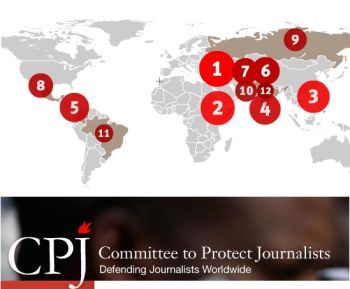 From Committee to Protect Journalists |
(WASHINGTON DC) - Deadly, unpunished violence against the press rose sharply in Pakistan and Mexico, continuing a dark, years-long trend in both nations, the Committee to Protect Journalists has found in its newly updated Impunity Index. The global index, which calculates unsolved journalist murders as a percentage of each country's population, shows that Pakistani authorities routinely fail to bring prosecutions in journalist murders, including several with suspected government links, while Mexican officials are yet to effectively combat the murderous crime groups targeting news media in vast parts of the nation.
"Impunity is the oxygen for attacks against the press and the engine of those who seek to silence the media," said Javier Garza, deputy editor of the Mexican daily El Siglo de Torreón. Gunmen have attacked his newspaper's Coahuila offices twice in the past four years and, though fatalities were avoided, no one has been arrested either. "These attacks made it clear to us that we can't trust the authorities for protection."
CPJ's index found improving conditions in Colombia and Nepal, along with a long-term decline in deadly, anti-press violence in Bangladesh that caused that country to drop off the list entirely. But the four worst nations in combating journalist murders—Iraq, Somalia, the Philippines, and Sri Lanka—showed virtually no sign of progress.
The release of CPJ’s index follows two significant international developments that take the fight against impunity in markedly different directions. In March, the Mexican Senate approved a constitutional amendment that, if adopted by the states, will federalize anti-press crimes and place national authorities in charge of such investigations, steps seen as crucial in fighting impunity in that country. But the same month, UNESCO's 28th biennial session failed to endorse a plan to strengthen international efforts to fight impunity after the proposal drew objections from Pakistan and two other member nations—India and Brazil—that have high rates of deadly, anti-press violence. The U.N. plan—which could still move forward despite the setback—would strengthen the office of the special rapporteur for free expression and assist member states in developing national laws to prosecute the killers of journalists.
CPJ's annual Impunity Index, first published in 2008, identifies countries where journalists are murdered regularly and governments fail to solve the crimes. For this latest index, CPJ examined journalist murders that occurred from January 1, 2002, through December 31, 2011, and that remain unsolved. Only the 12 nations in the world with five or more unsolved cases are included on the index. Cases are considered unsolved when no convictions have been won.
Iraq ranked worst on CPJ's Impunity Index for the fifth consecutive year and, with more than 90 unsolved murders, its impunity rating dwarfs that of every other nation. Most of the murders occurred as Iraq was immersed in war, but even now, as authorities claim stability, they have failed to bring justice in a single case. Somalia, gripped by insurgency and crippled by the lack of an effective central government, ranks second worst with 11 unsolved murders. In Sri Lanka, ranked fourth worst, authorities have failed to win convictions in the murders of nine journalists—all of whom reported critically about President Mahinda Rajapaksa's administration. Amid these conflict-ridden nations is a much different place, the Philippines, which is ranked third worst. Despite the Philippines' tradition of press freedom, the country's dysfunctional and corrupt criminal justice system has failed to bring justice in 55 journalist murders in the past decade.
Several countries' ratings remained largely static, underscoring how entrenched the culture of impunity can be. While Russian authorities have made modest progress in recent years in investigating journalist murders, the death toll grew in December 2011 with the murder in Dagestan of editor Gadzhimurad Kamalov, whose newspaper probed corruption, extremism, and human rights abuses. Brazil has seen a similar pattern: Even though prosecutors have won convictions in at least five cases over the last decade, recent journalist murders have kept the country on the index. Conversely, Afghanistan has made no progress in prosecuting journalist murders, but a slowdown in targeted killings caused its rating to improve slightly. The impunity rating for India, where successful prosecutions are rare, was virtually unchanged.
Not so in Pakistan, where the impunity rating worsened for the fourth straight year. Pakistani journalists face myriad threats "from murderous Taliban, violent sectarian parties, and intolerant religious and ethnic groups," said Najam Sethi, prominent editor of The Friday Times of Lahore, who himself faced such severe threats that he had to leave the country for a time. In addition, Sethi said, the powerful Inter-Services Intelligence Directorate "has shown unmistaken hostility toward journalists critical of the military's actions." Among the recent Pakistani victims was investigative reporter Saleem Shahzad, who was slain in 2011 after reporting on Al-Qaeda infiltration in Pakistan's navy.
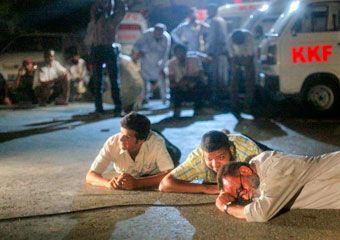 Pakistani reporter Saleem Shahzad was murdered after reporting that |
CPJ research shows that deadly, unpunished violence against journalists often leads to vast self-censorship in the rest of the press corps. Nowhere is that more apparent than in Mexico, where unsolved journalist murders grew for the third consecutive year. Fear of retaliation has driven some journalists to report crime news under pseudonyms on social media websites. But even those sites do not provide refuge: In September 2011, the decapitated body of Maria Elizabeth Macías Castro, a Mexican journalist who used social media to report crime news, was found alongside a computer keyboard and a note from a crime group claiming responsibility.
In addition to legislation federalizing crimes against the press, Mexico has undertaken other anti-impunity efforts such as the establishment of a journalist protection program modeled on an initiative undertaken in Colombia. Colombia, historically one of the world's deadliest countries for the press, has seen evidence of an improving climate in the past several years.
"The fight to end impunity in crimes against the press is a long and complicated struggle that has involved many actors, including journalists, press freedom groups, and, obviously, the government," said María Teresa Ronderos, a veteran Colombian journalist who now serves on CPJ's board of directors. She noted a number of successful prosecutions of journalists' killers, including the masterminds in some cases. "And this is a positive development. But there is still a lot of work to do because the majority of the cases remain unsolved. While lethal violence has receded, the number of threats has escalated and the investigations into these threats have gone nowhere."
Nepal, buoyed by convictions of suspects in two cases, also saw its impunity rating improve in the 2012 index. And for the first time since CPJ launched the index, Bangladesh is not listed. While no convictions have been recorded in journalist murders there over the last decade, a seven-year absence of journalist killings led Bangladesh to be dropped from the index.
Among the other findings in CPJ's Impunity Index:
- Local journalists are the victims in the vast majority of unsolved cases. Only 13 of the 247 cases on the index involved journalists working outside their own country.
- Political reporting was the most dangerous beat. Thirty percent of the victims included on CPJ's index covered political news.
- Even in conflict zones, the targeted killing of journalists is common. About 28 percent of journalists on the index were covering armed conflict when they were murdered.
- Threats are a strong indicator of potential deadly violence. In more than 40 percent of cases reviewed for the index, victims received death threats prior to their murders.
- Killers often try to send a chilling message to the rest of the press corps. In one out of five cases in the index, the victims were tortured before being killed.
For a detailed explanation of CPJ's methodology, click here.
CPJ's Impunity Index is compiled as part of the organization's Global Campaign Against Impunity, which is supported by the Adessium Foundation, the John S. and James L. Knight Foundation, the Omidyar Network, and the Open Society Foundations.
The Index
Here are the 12 countries where at least five journalists have been murdered and governments have failed to convict a single perpetrator. The index covers the years 2002-2011.
1 IRAQ
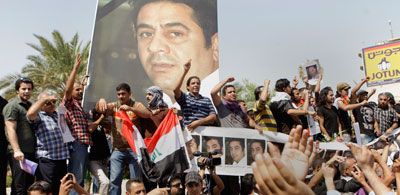 In Baghdad, protesters seek justice in the murder of Hadi al-Mahdi. |
No convictions have been obtained in 93 journalist slayings in the past decade. The pace of deadly violence has slowed since 2006 and 2007, when dozens of murders were reported amid sectarian violence, but journalists continue to be targets even now. In 2011, gunmen killed radio host and filmmaker Hadi al-Mahdi in his home in Baghdad. After returning home in 2008 after 18 years in exile, al-Mahdi denounced sectarianism and government corruption. He had been threatened in the months before his murder.
Impunity Index Rating: 2.906 unsolved journalist murders per million inhabitants
Last year: Ranked 1st with a rating of 2.921
2 SOMALIA
With 11 unsolved murders, Somalia ranks second for the third year in a row. The Somali press corps has faced an onslaught of attacks, most coming from Al-Shabaab militants. But transitional government forces have also menaced Somali journalists. In 2011, after covering a fractious session of the Transitional Federal Parliament, broadcast journalist Abdisalan Sheikh Hassan was shot in the head by a gunman wearing a military uniform. Unchecked violence against the media has forced at least 68 journalists to flee the Horn of Africa nation over the past decade.
Impunity Index Rating: 1.183 unsolved journalist murders per million inhabitants
Last year: Ranked 2nd with a rating of 1.099
3 PHILIPPINES
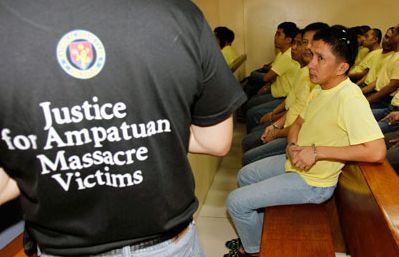 An advocate for the Maguindanao massacre victims appears at a court hearing |
Even after the horrific 2009 massacre in Maguindanao province that claimed the lives of 30 journalists and more than 20 other victims, Philippine authorities have yet to effectively combat impunity. The prosecution of dozens of politically connected suspects in the Maguindanao attack has been marked by delays and marred by allegations of bribery and witness intimidation. The overall death toll grew yet again in 2011 when a gunman shot Gerardo Ortega, a well-known journalist who covered environmental issues and corruption, in a clothing store. In March 2012, a local court issued an arrest warrant for Joel Reyes, a former governor of Palawan province, on charges of ordering Ortega's murder.
Impunity Index Rating: 0.589 unsolved journalist murders per million inhabitants
Last year: Ranked 3rd with a rating of 0.609
4 SRI LANKA
The government of Mahinda Rajapaksa has failed to prosecute any perpetrators in the nine murders that have taken place during his time in power, first as prime minister and then president. All of the victims had reported on politically sensitive issues in ways that were critical of the government. In 2006, for example, Tamil reporter Subramaniyam Sugitharajah was slain weeks after he reported on the killing of five Tamil students. Sugitharajah's photographs revealed the students died of gunshot wounds—contradicting military accounts that they were killed by their own grenade. In recent months, government officials have issued brazen public threats of violence against their critics, an alarming development given that 60 percent of Sri Lankan victims were known to have received threats before they were killed.
Impunity Index Rating: 0.431 unsolved journalist murders per million inhabitants
Last year: Ranked 4th with a rating of 0.443
5 COLOMBIA
As prosecutors have won a handful of convictions and the pace of journalist killings has slowed, Colombia's impunity rating has improved each year since 2008. But the nation's ranking remains unacceptably high, a legacy of its deadly past and its continued shortcomings in prosecuting open cases. At least eight journalist murders in the last decade remain unsolved. Among them is the case of Guillermo Bravo Vega, an award-winning investigative journalist who had exposed government corruption. Nine years after a gunman broke into Bravo's home and shot him in the head, the case remains unsolved.
Impunity Index Rating: 0.173 unsolved journalist murders per million inhabitants
Last year: Ranked 5th with a rating of 0.241
6 NEPAL
 Advocates for the slain journalist Uma Singh are buoyed by recent convictions in |
Weak law enforcement and a culture of political protection created the climate of impunity in Nepal, where five journalist murders remain unsolved. Maoist leaders, for example, have tried to block an investigation into the 2007 abduction and killing of journalist Prakash Singh Thakuri. Even after the Supreme Court ordered the Thakuri probe to go forward, authorities have produced no results. Nepal did achieve some notable success in two other cases, however. In 2011, two suspects were convicted in the killing two years earlier of Uma Singh, who had reported on sensitive issues such as women's rights and communal violence.
Impunity Index Rating: 0.167 unsolved journalist murders per million inhabitants
Last year: Ranked 7th with a rating of 0.205
7 AFGHANISTAN
Afghanistan's rating has remained largely static. While there have been no convictions in five journalist murders over the last decade, neither have there been any targeted killings since 2008. Among the unsolved cases is the 2006 murder of Zakia Zaki, founder of an independent radio station in Parwan province. The station was known for its coverage of local politics, women's issues, and human rights.
Impunity Index Rating: 0.145 unsolved journalist murders per million inhabitants
Last year: Ranked 6th with a rating of 0.235
8 MEXICO
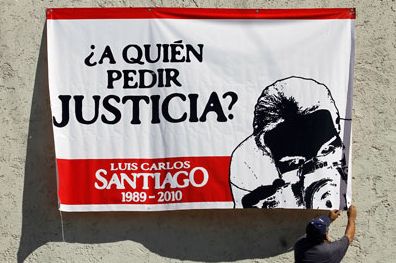 A banner seeks justice for photographer Luis Carlos Santiago, whose case |
The web of drug trafficking, crime, and official corruption that has fueled violence in large portions of the country has also had a devastating effect on the press. At least 15 journalist murders have gone unsolved in the past decade. But with 11 journalists reported missing during the period, and numerous others killed under unclear circumstances, Mexico's record is probably much worse. Vast self-censorship has taken hold as a result, prompting numerous news outlets to abandon coverage of crime and corruption. Gun battles in the streets of large cities such as Reynosa have gone uncovered, CPJ research shows. Journalists and citizens have turned to social media to exchange news of criminal activities—only to find peril there as well. The 2011 murder of Nuevo Laredo reporter Maria Elizabeth Macías Castro was the first case documented by CPJ worldwide in which a person was killed in direct relation to reporting done on social media.
Impunity Index Rating: 0.132 unsolved journalist murders per million inhabitants
Last year: Ranked 8th with a rating of 0.121
9 RUSSIA
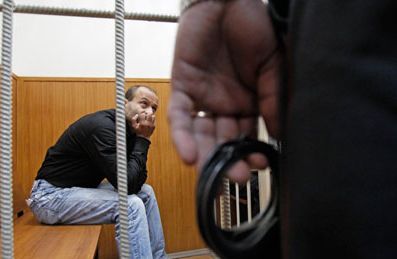 A retired police lieutenant colonel is detained in an investigation into the killing |
Russia's rating is unchanged, with 16 unsolved murder cases. The most recent victim was Gadzhimurad Kamalov, founder of the independent Dagestani weekly Chernovik, who was gunned down while leaving work in December 2011. The newspaper had received frequent threats for its coverage of government corruption, human rights abuses, and Islamic radicalism. Authorities have made modest progress in some cases: Several suspects were indicted last year in the 2006 killing of Anna Politkovskaya, but authorities have yet to bring the case to trial or identify the mastermind. "The impunity the masterminds enjoy—this is the main part of the mechanism, which breeds new murders," said Sergey Sokolov, deputy editor of Politkovskaya's newspaper, Novaya Gazeta.
Impunity Index Rating: 0.113 unsolved journalist murders per million inhabitants
Last year: Ranked 9th with a rating of 0.113
rating has worsened considerably in recent years. Intelligence and military officials are suspected to have played a role in a number of cases. In the months before he was murdered, for example, reporter Saleem Shahzad told friends and colleagues he was being threatened by the Inter-Services Intelligence Directorate. But the case, as with others, has not been credibly investigated by the government. After intense domestic and international outcry, Pakistan's government ordered a commission of inquiry into the Shahzad killing—but the resulting report was widely criticized for shying away from an examination of the intelligence service's possible role.
Impunity Index Rating: 0.109 unsolved journalist murders per million inhabitants
Last year: Ranked 10th with a rating of 0.082
11 BRAZIL
New attacks have set back Brazil's anti-impunity efforts. Courts have sentenced perpetrators in at least five journalist slayings in recent years, with authorities winning convictions of masterminds in at least two cases. But two murders in 2011 underscore the grave, ongoing risks facing provincial journalists who report on corruption, politics, and crime. In 2011, newspaper publisher Edinaldo Filgueira was shot multiple times after running a poll on his blog that reflected dissatisfaction with the local government. Five suspects have been arrested in the case. In all, CPJ research shows five unsolved murders in Brazil in the past decade.
Impunity Index Rating: 0.026 unsolved journalist murders per million inhabitants
Last year: Ranked 12th with a rating of 0.026
12 INDIA
With six unsolved murders, India retains its place on the index. All of the victims were print journalists who reported on crime, corruption, or politics. Despite India's status as the world's largest democracy and its tradition of having vibrant news media, its leaders have shown little political will to address impunity in attacks on news media. In March, India led opposition to the U.N. journalist safety plan that included anti-impunity efforts.
Impunity Index Rating: 0.005 unsolved journalist murders per million inhabitants
Last year: Ranked 13th with a rating of 0.006
Methodology
CPJ's Impunity Index calculates the number of unsolved journalist murders as a percentage of each country's population. For this index, CPJ examined journalist murders that occurred between January 1, 2002, through December 31, 2011, and that remain unsolved. Only those nations with five or more unsolved cases are included on this index.
CPJ defines murder as a deliberate attack against a specific journalist in relation to the victim's work. Murders make up more than 70 percent of work-related deaths among journalists, according to CPJ research. This index does not include cases of journalists killed in combat or while carrying out dangerous assignments such as coverage of street protests.
Cases are considered unsolved when no convictions have been obtained. Population data from the World Bank's 2010 World Development Indicators were used in calculating each country's rating.
CPJ welcomes comments about this index.
Statistical Table
Unsolved journalist murders per 1 million inhabitants for 2002-2011. Only nations with five or more unsolved cases are included. Cases are considered unsolved when no convictions have been obtained.
| Rank | Nation | Unsolved Cases | Population (in millions) |
Calculation | Rating |
| 1 | Iraq | 93 | 32 | 93/32 | 2.906 |
| 2 | Somalia | 11 | 9.3 | 11/9.3 | 1.183 |
| 3 | Philippines | 55 | 93.3 | 55/93.3 | 0.589 |
| 4 | Sri Lanka | 9 | 20.9 | 9/20.9 | 0.431 |
| 5 | Colombia | 8 | 46.3 | 8/46.3 | 0.173 |
| 6 | Nepal | 5 | 30 | 5/30 | 0.167 |
| 7 | Afghanistan | 5 | 34.4 | 5/34.4 | 0.145 |
| 8 | Mexico | 15 | 113.4 | 15/113.4 | 0.132 |
| 9 | Russia | 16 | 141.8 | 16/141.8 | 0.113 |
| 10 | Pakistan | 19 | 173.6 | 19/173.6 | 0.109 |
| 11 | Brazil | 5 | 194.9 | 5/194.9 | 0.026 |
| 12 | India | 6 | 1,170.9 | 6/1170.9 | 0.005 |
Population data source:
2010 World Development Indicators, World Bank
Country links:
Click on country links to view CPJ's comprehensive database of journalists murdered. The database covers the years 1992-2012.
Special thanks to the Committee to Protect Journalists
https://www.cpj.org/reports/2012/04/impunity-index-2012.php
 |
 |
 |
 |
 |
 |
Articles for April 17, 2012 | Articles for April 18, 2012 | Articles for April 19, 2012





Quick Links
DINING
Willamette UniversityGoudy Commons Cafe
Dine on the Queen
Willamette Queen Sternwheeler
MUST SEE SALEM
Oregon Capitol ToursCapitol History Gateway
Willamette River Ride
Willamette Queen Sternwheeler
Historic Home Tours:
Deepwood Museum
The Bush House
Gaiety Hollow Garden
AUCTIONS - APPRAISALS
Auction Masters & AppraisalsCONSTRUCTION SERVICES
Roofing and ContractingSheridan, Ore.
ONLINE SHOPPING
Special Occasion DressesAdvertise with Salem-News
Contact:AdSales@Salem-News.com
Terms of Service | Privacy Policy
All comments and messages are approved by people and self promotional links or unacceptable comments are denied.
[Return to Top]
©2025 Salem-News.com. All opinions expressed in this article are those of the author and do not necessarily reflect those of Salem-News.com.